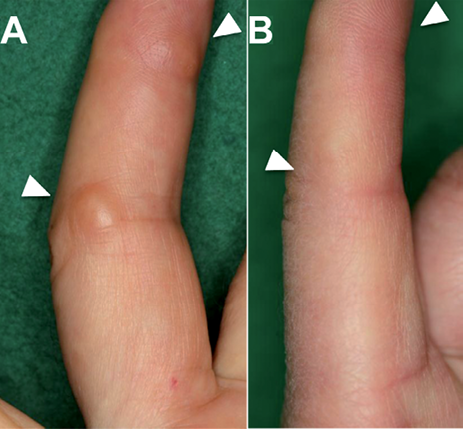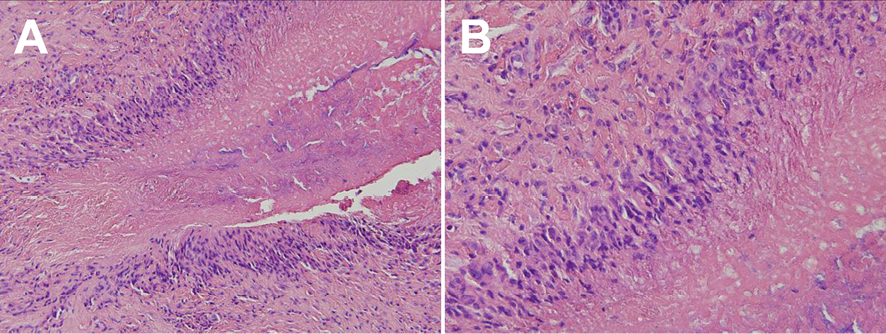Sei-ichiro Motegi and Osamu Ishikawa
Department of Dermatology, Gunma University Graduate School of Medicine, 3-39-22 Showa-machi, Maebashi, Gunma 371-8511, Japan. E-mail: smotegi@gunma-u.ac.jp
Accepted Jun 26, 2013; Epub ahead of print Oct 24, 2013
Rheumatoid nodules are characterised by subcutaneous nodular lesions at pressure areas, such as finger joints and the extensor area of the forearm. Rheumatoid nodules occur in approximately 30–40% of patients with rheumatoid arthritis (RA), and usually reflect high levels of disease activity and severity of RA (1, 2). Rheumatoid nodules are often confused with methotrexate (MTX)-induced accelerated nodulosis. MTX-induced accelerated nodulosis is characterised by multiple subcutaneous nodules occurring during MTX treatment for RA, and is seen in 8% or 11.6% of MTX-treated patients (3–5). Herein, we report a case of accelerated nodulosis during MTX therapy in a patient with RA and scleroderma.
CASE REPORT
A 68-year-old Japanese woman was diagnosed as having scleroderma, at the age of 61. The diagnosis was based on Raynaud’s phenomenon, skin sclerosis of bilateral fingers and arms, the pathological findings of fibrosis of the dermis of her forearm, as well as the presence of anti-centromere antibodies. Two years later, in 2007, the diagnosis of RA was established, based on arthritis of fingers and knees, swollen joints of hands, bone erosive lesions of fingers in X-ray analysis, and positive testing for rheumatoid factor and anti-circulated citrullinated peptide antibodies. Nodules on the fingers and hands were not observed. Treatment with oral MTX 4 mg/week was started from May 2008, and the dose of MTX was increased up to 8 mg/week from April 2009. In addition, treatment with etanercept 50 mg/week was started from August 2008. Three months after increase in the dose of MTX, the disease was well controlled.
In December 2011, after 3 years of treatment with MTX and etanercept, multiple indurated dome-shaped small nodules (< 5 mm) on her fingers were noticed (Fig. 1A), and the number rapidly increased. Some of nodules were observed in the extra-articular area of fingers. Histopathological examination of a nodule was performed under the differential diagnosis of MTX induced accelerated nodulosis or rheumatoid nodules, and showed the central fibrinoid necrosis surrounded by lymphocytes and epithelioid cells in a palisade arrangement (Fig. 2). Since the disease activity of RA was well controlled, we considered that these nodules were induced by the use of MTX, and treatment with MTX was stopped in September 2012, however, etanercept was continued. Four months later, most of subcutaneous nodules had disappeared (Fig. 1B), and local recurrence has not occurred during a 6-month follow-up period. In addition, the disease activity of scleroderma was also well controlled.
Fig. 1. Multiple indurated dome-shaped small nodules on fingers (A). Four months after discontinuance of methotrexate, almost all subcutaneous nodules had disappeared (B).

Fig. 2. Histopathological examination of a nodule. The central fibrinoid necrosis surrounded by lymphocytes and epithelioid cells in a palisade arrangement H&E: A: × 200, B: × 400).

DISCUSSION
Many case reports and reviews have been published on MTX-induced accelerated nodulosis. Most reported cases occurred in patients with RA and some in patients with systemic lupus erythematosus (SLE) treated with MTX (6). To the best of our knowledge, no report has been published about MTX-induced accelerated nodulosis in a patient with RA and scleroderma.
Kerstens et al. (3) reported that accelerated nodulosis occurred exclusively in patients receiving MTX, and the estimated incidence was 8% in a double-blind study. In addition, Berkun et al. (4) reported that overall rate of MTX-induced accelerated nodulosis was 11.6% of MTX-treated RA patients. Patatanian & Thompson (5) summarised 27 case reports of MTX-induced accelerated nodulosis, mentioning that 64% of the patients had finger involvement, and other sites were the elbows, knees and feet. In addition, they showed that the time between initiation of MTX administration and the occurrence of accelerated nodulosis was variable from 3 months to 12 years, and cumulative dose of MTX ranged from 90 to 7,200 mg. In our case, nodules were noticed 3 years after MTX administration, and the cumulative dose of MTX was approximately 1,800 mg.
It is known that the characteristic features of MTX-induced accelerated nodulosis compared with rheumatoid nodules are that MTX-induced nodules have a more rapid onset and growth, the size of nodules is smaller, and they follow a different distribution, such as on the hands, feet, and ears in comparison with around the articular area of fingers in rheumatoid nodules (3). In addition, accelerated nodulosis develops even when RA disease activity is well controlled.
Kekow et al. (7) reported etanercept-induced accelerated nodulosis in a patient with RA, and Cunnane et al. (8) reported that MTX-induced accelerated nodulosis was exacerbated by etanercept. In our case, treatment with etanercept was started 3 years before onset of accelerated nodulosis, suggesting that etanercept might have been responsible for nodulosis. However, the nodules disappeared after discontinuance of MTX even though etanercept was continued, indicating that accelerated nodulosis was induced by MTX.
The pathogenesis of MTX-induced accelerated nodulosis has not been elucidated. Merrill et al. (9) suggested that MTX induces adenosine production from infiltrating monocytes, which stimulates the adenosine A1 receptor, resulting in enhancement of giant cell formation in vitro. They concluded that drugs which inhibit adenosine A1 receptor might be useful for the treatment of MTX-induced accelerated nodulosis.
The primary treatment is discontinuance of MTX. However, Patatanian & Thompson (5) reported that nodules regressed by additional administration of anti-rheumatic drugs, incuding hydroxychloroquine, colchicine, sulfasalazine, azathioprine and D-penicillamine in some patients in whom MTX could not be discontinued. They suggested that physicians need to consider these treatment options when discontinuation of MTX is impossible.
Since most of MTX-induced accelerated nodulosis might be misdiagnosed as being rheumatoid nodules, MTX-induced accelerated nodulosis may not be so rare. Therefore, it is important for dermatologists and rheumatologists to make the distinction between MTX-induced accelerated nodulosis and rheumatoid nodules so an early diagnosis can be made and an appropriate treatment can be initiated.
The authors declare no conflicts of interest.
REFERENCES
